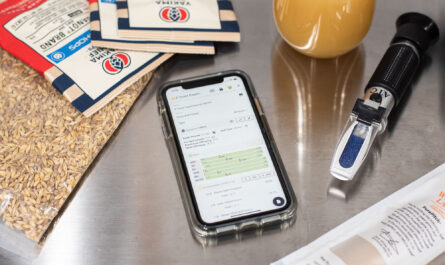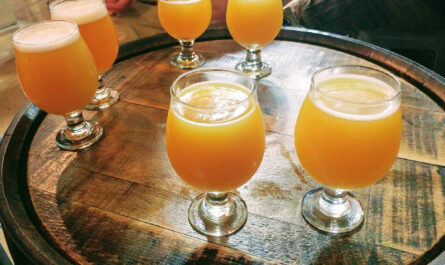I really love how this pineapple-inspired NEIPA came out. Thanks to a massive dry hop of Citra and BRU-1™, this beer packs a punch of tropical notes and unmistakable candied pineapple flavor. If you’re a pineapple lover, this beer is for you. This was my first time splitting my dry hop charge into two separate terminal charges. I opted for two 48-hour duration charges that absolutely deliver. Just to clarify, no actual pineapple is added to this recipe.
If you have a conical, I recommend you drop the hops out before adding the second charge. I guess it holds true that you really only need minimum contact time to extract max hop flavor. Absolutely a new favorite recipe.
Here’s a link to the recipe in Brewfather.
Ingredients
Fermentables
11 lb (66.7%) — Avangard Pilsner Malt — 1.8 °L
3 lb (18.2%) — Briess Oats, Flaked — 1.6 °L
1 lb 8 oz (9.1%) — Briess Wheat White Malt — 2.3 °L
1 lb (6.1%) — Simpsons Golden Naked Oats — 7.3 °L
First Wort
1 oz YVH CTZ (Tomahawk) 14% – FWH
Whirlpool
2 oz (15 IBU) YVH BRU- 14% — 30 min hopstand @ 180 °F
2 oz (13 IBU) YVH Citra 12% — 30 min hopstand
Dry Hops
2 oz YVH BRU-1 14% — Dry Hop — day 8
2 oz YVH Citra 12% — Dry Hop — day 8
2 oz YVH BRU-1 14% — Dry Hop — day 10
2 oz YVH Citra 5% — Dry Hop — day 10
1 oz YVH BRU-1 Lupomax (Cryo) 14% — Dry Hop — day 10
1 oz YVH Citra Lupomax (Cryo) 12% — Dry Hop — day 10
Yeast
2 packs Imperial Yeast Juice A38
Other
Whirlfloc – 15 minutes
Water Profile
Ca2+ 98
Mg2+ 12
Na+ 43
Cl– 200
SO42- 99
HCO3– 0
Specifications
Method: All-grain
Batch size: 5.5 gallons
Efficiency: 68%
OG: 1.075
FG: 1.019
ABV: 7.4%
IBU: 73
SRM: 5
Target Mash pH: 5.2 (adjust with lactic acid)
Post Boil pH: 4.9 (adjust with lactic acid with 15 min remaining)
Mash Temp: 152°F – 60 minutes
Boil: 60 minutes
Fermentation Temp: 68°F
Notes
Day 1: Pitch yeast at 68°F and let rise to 72°F on day 2-3 for the remainder of fermentation. Should finish in 4-5 days. Per Imperial Yeast: Target 20-25 ppm dissolved oxygen or set the oxygen regulator flow to 50% higher than normal.
Day 7: Drop the temperature to 55°F and hold for 24 hours.
Day 8: Add first dry hop charge, hold at 55°F at 7-10 PSI. Drop the hops out after 48 hours contact time if you have a conical and can.
Day 10: Add second dry hop charge. It’s important the Lupomax hops are added in the second charge.
Day 12: Crash to 33°F for 48 hours. Proceed with packaging/cold conditioning for another week in the keg at serving temps. Should be prime drinking by day 18-20.
This recipe puts 5.5 gallons into the fermenter but honestly, the final yield may vary due to the heavy dry hopping. Expect a decent loss from this. Read this article here first for an in-depth overview of brewing NEIPAs.
Use code HAZY20 to get 20% off your entire purchase of $100 or more at yakimavalleyhops.com.





Shawn you rock!
I really enjoy reading all of your work and can not wait to try some of your recipes. The level of detail and thorough analysis is really appreciated. I read tons of blogs and yours has to be one of the best I have come across. I am amazed at your dedication and willingness to share your results. Keep up the great work and if you ever need a hand let me know how I can help you.
John
Avid Brewer in Manchester, VT
Thanks, John – I really appreciate the kind words. Sharing is caring.
Looks delicious, I will try this for my next brew!
What’s the purpose of adjusting the post boil pH to 4.9?
Hey Shawn,
Also curious about the pH adjustment during boil. How are you going about measuring the pH (pull a few oz sample to measure) and how much Lactic Acid did you add?
Also, curious why it was important the LupoMax was added in the 2nd charge? I’m planning to do it for all of my hopping (minus extract hops at FWH) given less vegetal material and less absorption.
Exactly, I pulled a sample and added a little at a time and rechecked it. I used 100% distilled for this recipe and ended up adding about 2 ML of lactic acid during the boil. From what I’ve read it has to do with counteracting the increased pH as a result of heavy dry hopping. Also, I’ve read that lower boil pH also accentuates hops character over bitterness. Outside of that, I’ve heard a few bigger name breweries are doing the same thing. I’m going to monitor my results on this!
Hey Shawn, just found your site…very informative and interesting…nice work! I’ve thought about adjusting ph late boil but find it difficult to get the wort cooled quick enough for a reading. Any tips on how you measure the ph?
Shawn, I want to reach out and Thank you for providing Pineapple Express and Melcher Street recipes.
I have brewed both of them with outstanding success. Both are outstanding with a slight personal preference for Melcher Street.
Anyone looking for outstanding NEIPA recipes should put these two at the top of their list. I made a hop substation for Bru-1 in Pineapple Express since I did not have any, and it still came out incredible. I will be brewing it next time with Bru-1 for sure. Melcher was 100% Shawn’s recipe and everyone who has tried either is blown away with how well they both came out. Even my beer snob friends.
Thank you for sharing !
John
Awesome recipe! Would you use 1.3 lb/qt ratio for all grain?
Fantastic recipe! Have it in the conical now. Wondering if I’m supposed to apply pressure at day 7 prior to soft crash or if I should be fermenting under pressure the whole time? I took it as pressure prior to soft crash but now I’m questioning myself.
sorry for delay. never ferment neipas under pressure or you will suppress esters.
No worries. Wanted to check back in with you to let you know how it went. I substituted BRU-1 with mosaic because that’s what I had on hand. Beersmith had my estimated mash volume at 15.15 and I have a 15 gallon pot (BIAB). I figured I could push the limits and was wrong. Ended up having to pull out 1-1/2 gallons of mash water(scaled recipe to 9 gallon batch) to fit remaining grains, minus what overflowed. Had an absolutely great starter with the suggested Imperial Juice and fermentation went off like a rocket. This has honestly been one of the better NEIPA’s I’ve personally tasted. I’m not saying it’s the best for for what I’m looking for in a New England this completely hits the mark. I’m switching to a cooler mash with a bag on the next go round and will be using BRU-1. Cannot wait to see how it comes out. Thank you for the awesome recipe man!